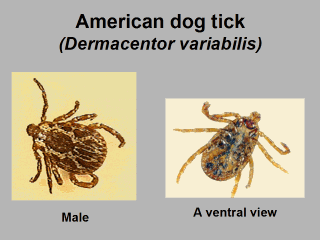| front |1 |2 |3 |4 |5 |6 |7 |8 |9 |10 |11 |12 |13 |14 |15 |16 |17 |18 |19 |20 |21 |22 |23 |24 |review |
 |
The American
dog tick, a 3-host tick, is widely distributed east of the Rocky Mountains
and along the Pacific coast. Dogs are the preferred host. They feed on many
large mammals including man. This tick transmits the causative pathogen of
Rocky Mountain spotted fever and possibly Q fever to humans. Q stands for
Queensland. The adult stage is identified by ornate markings on the scutum.
Also, they have 11 festoons, simple eyes and short mouthparts. American dog ticks prefer overgrown empty lots and the like, fields, and edges of paths and trails. They wait on grass (questing) and weeds for a suitable host to brush against the vegetation. Larval activity begins in early spring when they feed on rodents such as meadow voles and whitefooted mice, whereas the 8-legged nymphs may be found on whitefooted mice, cotton rats and rabbits during winter months. The female feeds, mates, becomes engorged and drops off to lay 1,000-3,000 eggs. The life cycle requires from 4 months to over a year. |